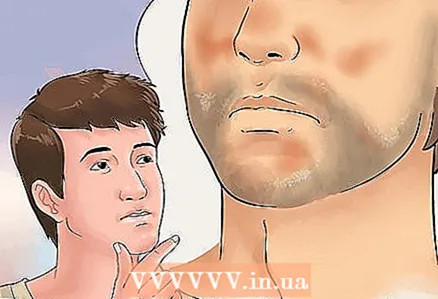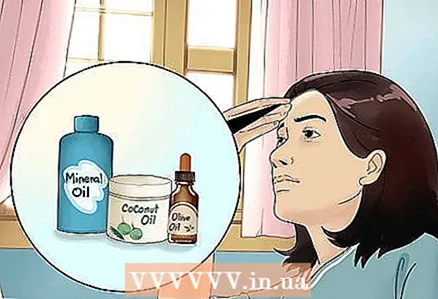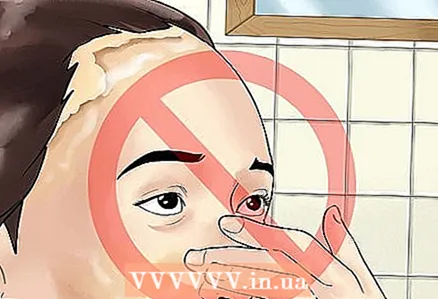Author:
Joan Hall
Date Of Creation:
1 July 2021
Update Date:
1 July 2024

Content
- Steps
- Part 1 of 3: Signs of seborrheic dermatitis
- Part 2 of 3: Self-management of the disease
- Part 3 of 3: Clinical Treatment
Seborrheic dermatitis causes redness, flaking and death of skin cells. It is also called dandruff (on the scalp under the hair), seborrheic eczema, or seborrheic psoriasis. In addition to the scalp skin, the disease also often manifests itself on the face. It does not indicate poor hygiene, is not transmitted between people and is not dangerous. But a person suffering from seborrheic dermatitis on the face almost always feels awkward. Fortunately, there is a solution to the problem.
Steps
Part 1 of 3: Signs of seborrheic dermatitis
 1 Identification of seborrheic dermatitis on the face. People are not surprised by the flaking of the scalp under the hair, but the disease can also manifest itself on other areas of the body with oily skin, including the face. Dead skin cells stick together under the influence of fat and get scaly formations of a yellowish tint. The disease has the following symptoms:
1 Identification of seborrheic dermatitis on the face. People are not surprised by the flaking of the scalp under the hair, but the disease can also manifest itself on other areas of the body with oily skin, including the face. Dead skin cells stick together under the influence of fat and get scaly formations of a yellowish tint. The disease has the following symptoms: - Oily white or yellow scaly growths on the ears, nose, and other areas of the face
- Dandruff on the eyebrows, beard, or mustache
- Redness
- Red eyelids crusty dry skin
- Itchy or burning scaly areas
 2 When to see a doctor. If it looks like you are having complications, or you are very upset with your skin condition, then seek help from your doctor. Reasons to see a doctor:
2 When to see a doctor. If it looks like you are having complications, or you are very upset with your skin condition, then seek help from your doctor. Reasons to see a doctor: - You are overwhelmed by the condition of your facial skin, it prevents you from living a normal life. The disease resulted in anxiety, indecision and insomnia.
- You suspect an infection. If the affected areas hurt, bleed, or fester, then you are almost certainly infected.
- If self-medication does not help, then be sure to see a doctor.
 3 Determine if you are prone to seborrheic dermatitis. This situation can complicate the treatment process. In the following cases, you'd better see a dermatologist:
3 Determine if you are prone to seborrheic dermatitis. This situation can complicate the treatment process. In the following cases, you'd better see a dermatologist: - You have a mental disorder like Parkinson's disease or depression.
- You have weak immunity. This applies to people after organ transplantation, HIV-infected people, suffering from alcoholic pancreatitis or cancer.
- You have heart problems.
- You have damaged facial skin.
- You are exposed to extreme weather conditions.
- You are obese.
Part 2 of 3: Self-management of the disease
 1 Wash your face twice a day. This will help flush away excess oil and prevent dead skin cells from sticking to your skin.
1 Wash your face twice a day. This will help flush away excess oil and prevent dead skin cells from sticking to your skin. - Use a mild soap that will not irritate your skin.
- Do not use products containing alcohol. Skin irritation will only make the situation worse.
- Use non-greasy moisturizers that won't clog your pores. The label should state that the product does not cause acne breakouts.
 2 Try medicated shampoos. The shampoo is intended for the scalp, but it can also help fight seborrheic dermatitis on the face. Rub the shampoo into your skin with gentle movements and leave for the recommended time. Then rinse your skin thoroughly with water. You can try this:
2 Try medicated shampoos. The shampoo is intended for the scalp, but it can also help fight seborrheic dermatitis on the face. Rub the shampoo into your skin with gentle movements and leave for the recommended time. Then rinse your skin thoroughly with water. You can try this: - Shampoos with zinc pyrithione (Head & Shoulders) or selenium (Selsun Blue). They can be used daily.
- Antifungal shampoos. They should be used no more than twice a week. You can use your daily shampoo in between.
- Tar shampoos (Neutrogena T / Gel, DHS Tar). They can cause contact dermatitis, so this shampoo should only be applied to areas with seborrheic dermatitis.
- Shampoos with salicylic acid (Neutrogena T / Sal). They can be used daily.
- Try everything to find out which one works best. You can also use shampoos alternately if they lose their effectiveness over time. Avoid getting shampoo in your eyes.
- Pregnant and lactating mothers should consult a doctor beforehand.
 3 Soften flaking with oil. This method will allow you to easily and painlessly remove some of the exfoliated skin. Massage the oil into the flaky areas and let it absorb. After an hour, wash off with warm water. Then wipe with a damp sponge to remove softened dead cells. You can use a variety of oils, guided by your own preference:
3 Soften flaking with oil. This method will allow you to easily and painlessly remove some of the exfoliated skin. Massage the oil into the flaky areas and let it absorb. After an hour, wash off with warm water. Then wipe with a damp sponge to remove softened dead cells. You can use a variety of oils, guided by your own preference: - Popular baby oils. They are best suited for children.
- Mineral oil
- Olive oil
- Coconut oil
 4 Apply warm compresses. This method is especially good for peeling skin on the eyelids.
4 Apply warm compresses. This method is especially good for peeling skin on the eyelids. - Make a warm compress by soaking a clean towel in warm water. This method is gentle enough for the delicate skin around the eyes and does not involve the use of soap.
- Apply a compress to your eyelids to soften the dead skin and remove easily.
- Don't try to peel off the crust if it doesn't come off effortlessly. There is no need to injure the skin so as not to infect.
 5 Avoid increasing the oily skin of your face. Unlike oil, which softens dry skin, the secreted sebum stays on it for hours. This leads to the clumping of dead cells in areas with healthy skin. To reduce the oily skin, you can use the following recommendations:
5 Avoid increasing the oily skin of your face. Unlike oil, which softens dry skin, the secreted sebum stays on it for hours. This leads to the clumping of dead cells in areas with healthy skin. To reduce the oily skin, you can use the following recommendations: - Tie long hair into a ponytail to keep the oil out of the hair on your face.
- Don't wear a hat. The hat absorbs grease and is in constant contact with the skin.
- Shave off your beard or mustache if you have seborrheic dermatitis. So it will be easier for you to cure the disease and prevent the situation from worsening due to the oily mustache or beard.
 6 Use over-the-counter medications. They help reduce redness and, if an infection occurs, they help get rid of it.
6 Use over-the-counter medications. They help reduce redness and, if an infection occurs, they help get rid of it. - Use a cortisone cream to relieve itching and inflammation.
- Use an antifungal cream like Ketoconazole. It prevents or kills fungal infections and relieves itching.
- Read and follow the instructions on the packaging. Pregnant and lactating mothers should consult a doctor beforehand.
 7 Itching needs to be treated, not scratched. Scratching can irritate your skin and run the risk of infection. In such cases, it is better to use medications for itching:
7 Itching needs to be treated, not scratched. Scratching can irritate your skin and run the risk of infection. In such cases, it is better to use medications for itching: - Hydrocortisone. It reduces itching and inflammation but, with continued use, results in thinning of the skin.
- Calamine lotion. It relieves itching, but can dry out the skin.
 8 Alternative medicine. These treatments have not undergone rigorous scientific testing, but there is a widespread belief that they are quite effective. Before treatment with non-traditional methods, it is always necessary to consult a doctor so as not to make things worse. This is especially important for nursing mothers and pregnant women.The following treatment options are common:
8 Alternative medicine. These treatments have not undergone rigorous scientific testing, but there is a widespread belief that they are quite effective. Before treatment with non-traditional methods, it is always necessary to consult a doctor so as not to make things worse. This is especially important for nursing mothers and pregnant women.The following treatment options are common: - Aloe. You can buy and use a ready-made product, but if an agave grows in your home, you can simply cut the leaf to get juice. Apply cooling and soothing aloe juice to your skin.
- Fish oil supplements. Fish oil contains omega-3 polyunsaturated fatty acids, which have a beneficial effect on the code. Start taking these supplements.
- Tea tree oil. Tea tree oil has antiseptic properties that can help fight infections that prevent skin from healing. Apply a 5% solution of tea tree oil. Mix 1 part tea tree oil with 19 parts warm water. Using a sterile cotton swab, apply the solution to the affected skin and let sit for about 20 minutes. Then rinse off the solution. It is important to know that some people are allergic to tea tree oil.
 9 Reduced stress. Stress can lead to hormonal changes that increase your susceptibility to skin problems. Here are some options for dealing with stress:
9 Reduced stress. Stress can lead to hormonal changes that increase your susceptibility to skin problems. Here are some options for dealing with stress: - Exercise for at least 2.5 hours per week
- Eight Hours of Night Sleep
- The use of relaxation techniques: meditation, massage, visualization of soothing images, yoga and deep breathing.
Part 3 of 3: Clinical Treatment
 1 Ask your doctor about medications that reduce inflammation. He may prescribe a cream or ointment for you. It is important to remember that with prolonged use, some of them can lead to skin thinning:
1 Ask your doctor about medications that reduce inflammation. He may prescribe a cream or ointment for you. It is important to remember that with prolonged use, some of them can lead to skin thinning: - Hydrocortisone cream
- Fluocinolone
- DesOwen, Desonide
 2 Use the prescribed antibacterial agent. Common options include metronidazole (MetroLotion, Metrogel), which comes in the form of a tropical cream or gel.
2 Use the prescribed antibacterial agent. Common options include metronidazole (MetroLotion, Metrogel), which comes in the form of a tropical cream or gel. - Use as directed.
 3 Discuss using antifungal medications with other medications. If the doctor thinks that a fungal infection is preventing treatment, this may help, especially if the skin underneath the mustache or beard is affected:
3 Discuss using antifungal medications with other medications. If the doctor thinks that a fungal infection is preventing treatment, this may help, especially if the skin underneath the mustache or beard is affected: - Use antifungal shampoo and clobetasol (Temovat) alternately
- Try oral antifungals like terbinafine (Lamisil). However, these drugs can cause severe allergic reactions and affect the liver.
 4 Discuss the use of an immunomodulator. These drugs reduce inflammation by suppressing the immune system. However, they increase the risk of cancer. They usually contain calcineurin inhibitors:
4 Discuss the use of an immunomodulator. These drugs reduce inflammation by suppressing the immune system. However, they increase the risk of cancer. They usually contain calcineurin inhibitors: - Tacrolimus (Protopic)
- Pimecrolimus (Elidel)
 5 Combination of phototherapy and drugs. A product called Psoralen increases your UV sensitivity. After taking the medication, a course of phototherapy is underway to combat seborrheic dermatitis. But this treatment can have dangerous side effects.
5 Combination of phototherapy and drugs. A product called Psoralen increases your UV sensitivity. After taking the medication, a course of phototherapy is underway to combat seborrheic dermatitis. But this treatment can have dangerous side effects. - There may be an increased risk of skin cancer.
- When phototherapy, you must use glasses with UV protection to prevent eye damage and cataracts.
- This type of treatment is not suitable for children.



